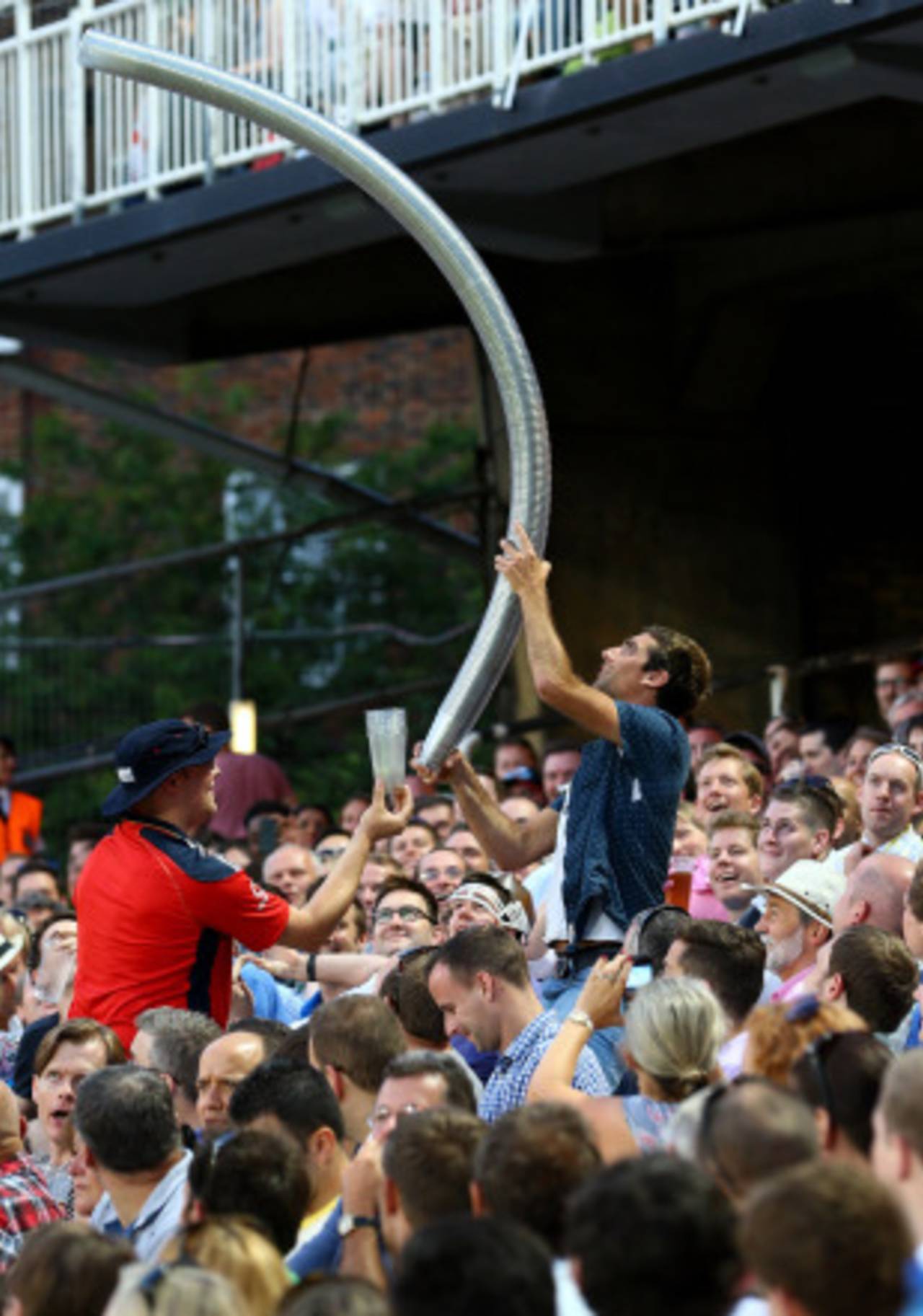Full houses and full pints at Twenty20
The signs from this season is that Friday night Twenty20 is the way forward, and from next summer that will be norm, but it does provide a new set of challenges
Tim Wigmore
06-Aug-2013

The crowds have flocked to Twenty20 and have availed themselves to a variety of entertainments • Getty Images
County cricket is an odd specimen. It spends its whole existence bemoaning that it's not like football - and then, when it starts to resemble it, recoils. Football crowds - oh, the horror.
T20 has got its swing back. After a disappointing Friends Life T20 competition in 2012 - hampered by awful weather - packed houses have reigned. Over 50,000 spectators attended games over two nights in London; Headingley witnessed its first county capacity crowd for nine years. T20 is the toast of county chairmen from Derbyshire to Somerset.
No Olympics, no football and some exquisite evenings have all helped, but so have improved marketing and a more coherent schedule. To pack out international venues for a domestic match in an age when county cricket largely exists without either England players or genuine overseas stars - and when the IPL is the only cricket on free-to-air TV - is an impressive feat. And it should only get better next year, as matches are played regularly on Friday evenings throughout the summer.
But not everyone is celebrating. A lot of T20 fans are football ones who want another sport to pass the summer by. There is even one area in which the cricket experience indisputably trumps the football one: you can drink in the ground.
Whatever the merits of the cricket, the booze can certainly add to them. I learned as much when I went to a pulsating London Derby at The Oval recently. For several of the friends I went with, it was their first live cricket experience. Afterwards, they could not contain their excitement at seeing Ricky Ponting in the flesh, Paul Stirling's power or Jade Dernbach's sorcery. That's in an ideal world.
In mundane reality, all this cricketing excitement was secondary to the beer snakes and the streaker (not quite in a classical sense, for he was wearing green underpants) who ran almost the entire pitch until being stopped. The booziness was emphatically a Good Thing. It is a big part of why they want to come again. And so it is for thousands of others. The triumph of beer over cricket was such that many people did not register when the match was over.
It would be great if everyone who went to county T20 was enthralled by Dernbach's assortment of slower balls. They're not. But it is much better for county cricket if people are there on Friday nights, boozing away, than not there at all.
It is also much better for county coffers. A sell-out T20 at The Oval makes more money for Surrey than days of Test cricket do at some grounds. The booze queues are a very big part of the reason why. If people want to pay £20 to have the right to buy pints at £4.20 apiece that, providing these people are not obnoxious and don't detract from the fun enjoyed by others, is good for county cricket.
But it's not only the Disgusted of Tunbridge Wells brigade who recognise that the masses can bring some unwelcome baggage. Deep into a tight run chase, fans deserve better than missing every other ball because someone in front has just bought another round. The sight of spectators getting so rowdy that they need to be escorted out of the ground has become a familiar one.
And sometimes it can get very ugly indeed. At the Warwickshire-Worcestershire game at Edgbaston this season, under-stewarded parts of the Hollies Stand witnessed nasty skirmishes between fans, which spilled over outside the ground after the game.
Much more of this and cricket grounds, like football in the 1980s, might have 'no go areas'. More stewards, acting proactively against provocative behaviour without being officious, are needed. It might also be time to consider a half-hour 'cooling off period' early in the second innings in which no booze is served.
Booze-free family enclosures would encourage parents to go with their children, without being worried that the kids will be exposed to expletive-ridden chanting. The alternative is a Friday night at the summer game no longer being deemed a family-friendly affair.
This unseemly behaviour of a few is not representative: most of those who go to the cricket and drink do not cause trouble. As Friday night T20 takes off, different audiences will want different things. And while cricket cannot afford to be unwelcoming to families, county T20 may also want to consider American-style roving beer sellers in small segments of the ground.
This would be controversial, but it would be selling to people who would be drinking anyway: the main effect, as long as stewards were alert, would be to reduce the amount of cricket missed through getting a drink or others moving back to their seats at an inopportune moment.
The time has also come to extend the ten-minute interval between innings. When T20 was devised a decade ago, everything was done to minimise the length of it all, as if not to give people enough time to realise they were watching cricket. At sell-out grounds the innings break often doesn't allow time to get a drink or go to the loo, let alone both.
In descriptions of 'raucous' or 'rowdy' T20 crowds, the implication has seemed that cricket hasn't seen anything quite like this before - ignoring that cricket and drinking have always been easy bedfellows.
T20 might cater to many who care more about drinking than the intricacies of the lbw law. But it ought to be perfectly possible to accommodate these without alienating more traditional fans.